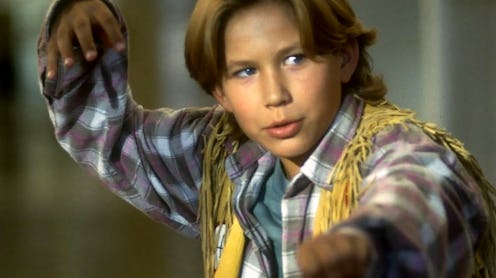Life
Why '90s Crushes Were Better Than Today's Crushes

When I was a kid in the '90s, Jonathan Taylor Thomas was my North Star. The sand-haired, ocean-eyed tween heart-throb was not only my crush, but the focal point of my young, directionless life. He existed only on TV, at the movies and in the tear-outs of teen magazines — which manifested on the walls of my childhood bedroom.
For my eleventh birthday, I had a Man of the House birthday party to which I invited a dozen of my closest friends to watch the VHS while wearing "We <3 JTT" t-shirts that we made with tie-dye and fabric pens. Every time our beloved crush came into frame, we'd squeal. We'd jump up and down. We'd squeeze each other's hands. We were like our mothers watching Elvis sway his hips. We turned into an unruly group of teen hungry hunters.
The allure of '90s heartthrobs was founded in their unavailability. All of our fun facts were derived from interviews. When he told the magazine that milk was his favorite drink, tweens across the country had stronger bones in six months. When he told the magazine that he liked the Rolling Stones, tweens across the country bought out the "Forty Licks" t-shirt inventory. He, like other tween heartthrobs of the '90s, was intangible. They were untouchable. In order to be a fan, you had to infect yourself with a feverish obsession that gave you the will to wait months between public appearances and interviews. Nothing will make you hungry like taking crumbs.
But the famous crushes don't crush the same anymore. The landscape of celebrity has changed. These are 11 reasons crushes were more fun in the '90s than they are now:
They Had An Air Of Mystery
Back then, stars were just that. We, the people, were not as interested in humanizing celebrities. We liked them to be bigger than us. We liked them to be out-of-reach and godly. We didn't know what they were like in their private lives. We didn't know about their bathroom habits or body odors or shower signing voices. We only knew the good stuff, and that was more fun to focus on.
They Weren't On Instagram
We only saw them in the best lighting. We didn't see pictures of them in their sweatpants, or smoking cigarettes or hungover eating burritos with their friends. They weren't sharing their private pictures with us so we could only imagine what their lives were like outside of the screens and magazines.
Fandom Was A Group Sport
Being obsessed with a movie star was a group effort. It was a bonding experience. It brought us together and gave us a unified cause. It made us feel closer, to all love the same thing.
Media Catered To Us
The magazines knew we were obsessed and gave us what we wanted to perpetuate it. *Juicy* interviews where they'd talk about the things they like look for in lovers, to give us things to aspire to. They had fold-down pictures, perfect for locker doors and bedroom walls. The media continuously added kindle to the fire of our pre-pubescent hearts.
They Couldn't Tweet
Celebrities couldn't share their political opinions or lose fans by spelling "you're" as "your". They couldn't go on drunken rants where they insult people or squash their allures. We couldn't reach out to them, there was no thru-line.
Their Secrets Didn't Have A Platform
Now, if a celebrity does something in public or involving a non-famous person, it's bound to make its way to the internet. If they get in a fight or go to rehab, it will end up on a message board and be viral information by morning. They could keep their faults and fowls from their fans.
They Needed Us
Without our cartoon hearts for eyes, the studios wouldn't have worked with them as much as they did. These stars relied on our obsession to get the roles and freedom they wanted. We scratched each other's backs.
They Had Franchises
It was socially acceptable to wear JTT pajamas and have a Devon Sawa binder for school. Department stores cashed in on the tween crazes and let us collect the manifestations of our fandom.
We Could Fantasize
We were still young enough that we could trick ourselves into thinking that one day we'd marry these people. That we'd meet and fall in love. That they might see us in the crowd and bring us on stage. That they might respond to our fan mail. We could still dream.
They Gave Us Something To Look Forward To
We picked the heartthrobs that had certain qualities that we liked in people. We liked one person because they were nice to their younger siblings. We liked another person because they could build things with their hands. We could look forward to finding people with similar traits. These heartthrobs made us believe there were others out there.
They Gave Us Something To Do
At the very least, celebrity obsession was something to do. It was a concert to attend. It was a movie to watch. It was a magazine to read. It was something to have in common with other people our age. Celebrity obsession was a full-time job in the '90s. A job that we were all happy to have.
Images: Giphy, All Girl Productions